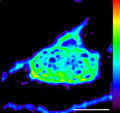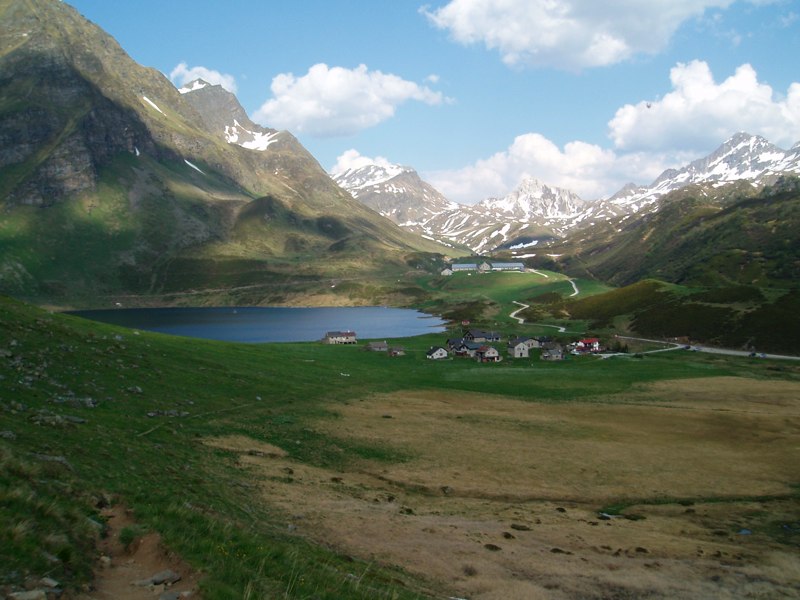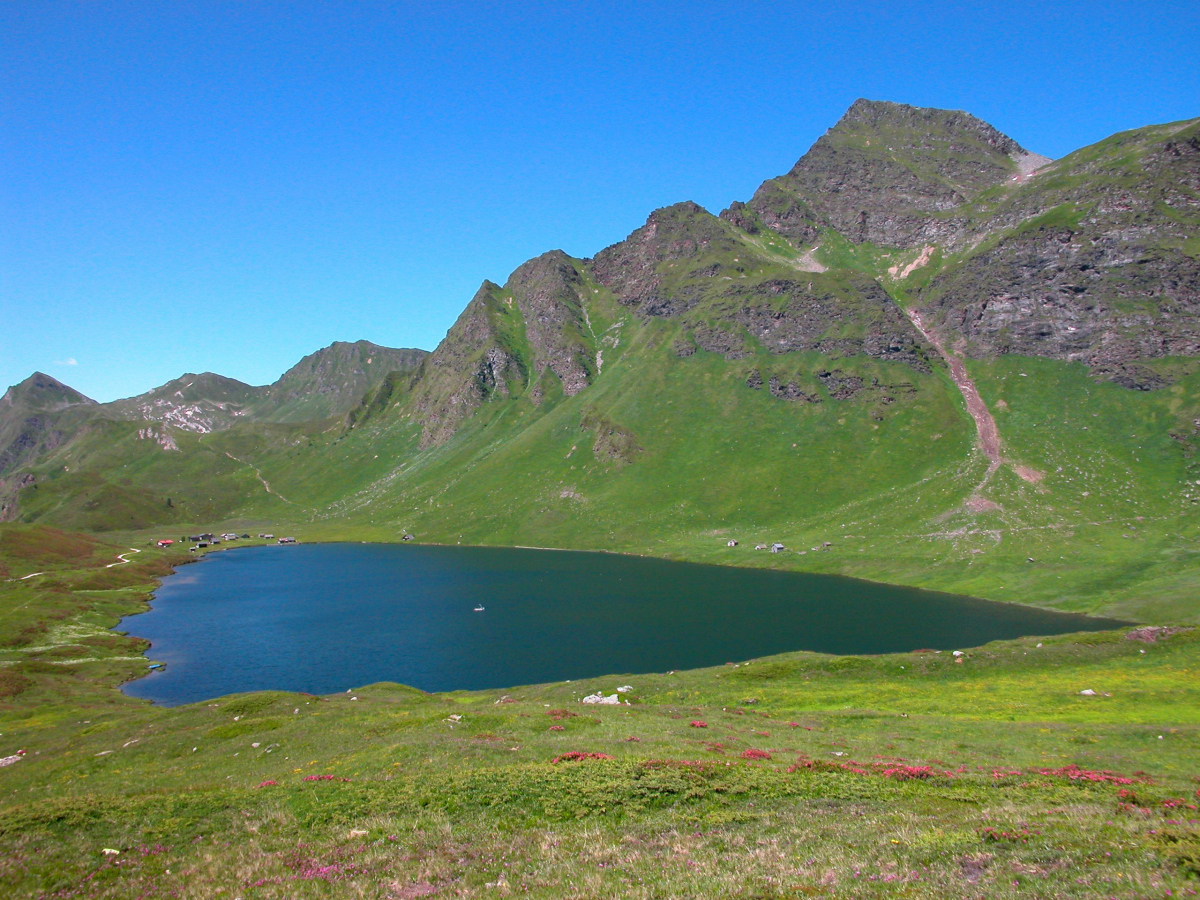Page path:
- Press Office
- Highlights 2000 - 2011
- 31.10.2008 Watching microorganisms at work
31.10.2008 Watching microorganisms at work
Watching microorganisms at work
Minorities accomplish most
Microorganisms are everywhere – but who does what, and when?
Niculina Musat from the Max-Planck-Institute for Marine Microbiology in Bremen, Germany, and an international group of scientists managed to directly determine nutrient uptake by individual bacterial cells in the environment. The scientists compared the ammonium and carbon uptake of three species of bacteria in Lake Cadagno, an alpine lake in Switzerland. Their surprising results were now published in the „Proceedings of the National Academy of Science“ (PNAS): The lion’s share of the lakes nutrient uptake was accomplished by a tiny part of the bacterial community. The species constituting only 0.3 percent of all bacterial cells was responsible for more than 40 percent of the ammonium- and 70 percent of the carbon uptake.
Microorganisms are everywhere – but who does what, and when?
Niculina Musat from the Max-Planck-Institute for Marine Microbiology in Bremen, Germany, and an international group of scientists managed to directly determine nutrient uptake by individual bacterial cells in the environment. The scientists compared the ammonium and carbon uptake of three species of bacteria in Lake Cadagno, an alpine lake in Switzerland. Their surprising results were now published in the „Proceedings of the National Academy of Science“ (PNAS): The lion’s share of the lakes nutrient uptake was accomplished by a tiny part of the bacterial community. The species constituting only 0.3 percent of all bacterial cells was responsible for more than 40 percent of the ammonium- and 70 percent of the carbon uptake.
Unlike most lakes, Lake Cadagno is permanently stratified (meromictic). The transition zone between the upper oxygen containing and the lower oxygen-free layer is the habitat of Chromatium okenii, Lamprocystis purpurea and Chlorobium clathratiforme – all of these microorganisms like plants use sunlight for photosynthesis but unlike plants grow in environments lacking oxygen. Chlorobium clathratiforme is the most abundant species accounting for up to 80 percent of all cells in the investigated layer. Nevertheless, C. clathratiforme was responsible for only about 15 percent of the total ammonium and carbon uptake. Lamprocystis purpurea, an abundant, small species, took up less than 2 percent of the investigated nutrients. Surprisingly, the comparatively large Chromatium okenii cells, comprising a tiny part of the bacterial community, accounted for the bulk of the ammonium and carbon uptake.
„Most studies on the ecology of microbial communities deal with the abundant organisms. This is also true for genetical analyses of environmental samples. Groups of microorganisms with a frequency of less than one percent, however, are often neglected and regarded as minor or of no importance. However, our results clearly show that exactly those minorities can be essential for the understanding of an ecosystem. Neglecting them can easily lead to erroneous conclusions“, underlines co-author Marcel Kuypers.
Comparing cells within one species, Musat and her colleagues found even more surprises: nutrient uptake rates vary greatly between individual cells of the same species, showing that microbial populations in the environment are heterogeneous, being comprised of physiologically distinct individuals. The scientists suspect genetic reasons for this heterogeneity. Differences between individual cells probably result from minor variability within the genome, springing from mutations during evolution.
The results at hand are available thanks to the so-called ‘nanoSIMS’-Technology. The scientists from the Max-Planck-Institute in Bremen operate their nanoSIMS since mid 2008 and have optimized this special mass spectrometer for ecological issues. This allows them to analyze the distribution of virtually any element from the periodic table within single cells. At the same time, single microbial cells are identified by the scientists applying molecular techniques. „This method will revolutionize ecological investigations“, Marcel Kuypers says.
Manfred Schlösser
Fanni Aspetsberger
Fanni Aspetsberger
For further information please contact:
Dr. Marcel Kuypers 0421 2028 647
Dr. Niculina Musat 0421 2028 653
or the MPI press officers
Dr. Manfred Schlösser 0421 2028704
Dr. Fanni Aspetsberger 0421 2028 704
Dr. Marcel Kuypers 0421 2028 647
Dr. Niculina Musat 0421 2028 653
or the MPI press officers
Dr. Manfred Schlösser 0421 2028704
Dr. Fanni Aspetsberger 0421 2028 704
Participating institutions
Max Planck Institute for Marine Microbiology, Celsiusstrasse 1, 28359 Bremen, Germany
Max Planck Institute for Chemistry, Joh.-J.-Becher Weg 27, 55128 Mainz, Germany
Cantonal Institute of Microbiology and Alpine Biology Center Foundation Piora, Via Mirasole 22A, CH-6500 Bellinzona, Switzerland
Cameca, Quai des Gresillons 29, 92622 Gennevilliers Cedex, France
Max Planck Institute for Marine Microbiology, Celsiusstrasse 1, 28359 Bremen, Germany
Max Planck Institute for Chemistry, Joh.-J.-Becher Weg 27, 55128 Mainz, Germany
Cantonal Institute of Microbiology and Alpine Biology Center Foundation Piora, Via Mirasole 22A, CH-6500 Bellinzona, Switzerland
Cameca, Quai des Gresillons 29, 92622 Gennevilliers Cedex, France
Lake Cadagno in the southern swiss alps has a speciality: Salty spring at the lake bottom prevent mixing, resulting in a stable stratification. The upper 11 metres contains oxygen but little nutrients (phosphate and ammonium). The bottom layer is enriched in nutrients. A stable intermediate layer shows steep gradients of oxygen, sulphate and sulfide. There the three investigated microbial species use light energy to oxidize sulfide. (Upper picture: CarriAyne Jones, lower picture: Sandro Peduzzi)
Nano-SIMS pictures show single cells and their uptake of labelled nitrogen and carbon. Here we see a cell of C. okenii. (Photo: Niculina Musat, MPI Bremen)



